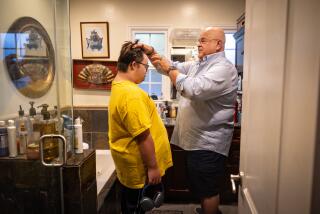New Financial Plan Lets CHOC Bounce Back
- Share via
Reversing a string of deficits, Orange County’s only specialty pediatric medical center is on the road to breaking even for the first time since 1994.
Officials for Children’s Hospital of Orange County--which has lost more than $43 million since 1995--say the key to the turnaround is a three-year plan that imposes tough financial controls and markets CHOC as the place to go, not just for complex children’s procedures, but for all types of pediatric treatment.
The result, current projections show, is that the hospital will end a five-year string of red ink when the books close on the current fiscal year on June 30, according to CHOC President Kimberly Cripe.
“We got a little bit of everybody’s business,” said Cripe, explaining one factor in the turnaround.
Not so long ago, the future looked grim for CHOC; the hospital lost nearly $20 million in the 1996-97 fiscal year alone. Hospital officials knew they could not sustain such extraordinary losses over the long run.
“We were never in immediate danger of closing,” Cripe said. “What was problematic was that losses were growing, they were accelerating. There was a high priority to minimize the operating losses.”
The financial resuscitation of the 35-year-old hospital is a success story for the entire county, several health care experts said.
“They do things at CHOC that still can’t be done at other facilities,” said Jon Gilwee, a vice president with the Healthcare Assn. of Southern California, a hospital trade group. “They are the resource in the county for a multitude of treatments.”
CHOC’s financial picture began to darken in fiscal 1995. The losses became a flood in 1997, as the hospital found itself ill-prepared for the changing health care market. It was caught short by the combined pressure of being an expensive child-centered hospital smack in the middle of Southern California’s most competitive managed-care environment, experts said.
While these problems individually are not unique, and affect pediatric hospitals across the nation, CHOC’s difficulties were more severe.
“The degree and intensity of challenge was accentuated by the unique circumstances [CHOC] found itself in,” said Lawrence McAndrews, president of the National Assn. of Children’s Hospitals and Related Institutions. “Children’s hospitals in general are experiencing declines in net profitability of from 6% to 2% on average nationwide.”
CHOC also had management problems, and further, had to contend with an explosion of managed care in Orange County at a time when more than 200,000 Medicaid patients were switched to managed care under the county’s CalOptima plan in late 1995 and early 1996.
“It required enormous change,” said Cripe, who took over as president and chief executive officer in 1997, and helped write the three-year strategy. “We really weren’t prepared for the managed-care market. It hadn’t been part of the children’s hospital scenario.”
Managed Care Cut Length of Stays
CHOC’s problems grew from a loss of $5.5 million in fiscal 1995, to $8.5 million in 1996, to $19.4 million in mid-1997; all on revenue averaging $110 million. All the while, the number of patients and patient days were dwindling. For instance, patient admissions fell from 7,497 in 1995 to 5,439 in 1998.
Managed care had reduced the length of hospital stays and switched many in-house procedures to less expensive outpatient treatment. At the same time, other hospitals dealt with their managed care problems by chasing the lucrative pediatric care business.
“You have hospitals sitting with empty beds and there was a push put on by certain adult hospitals to look to pediatric services to fill the gap,” said Kerri Ruppert, CHOC’s chief financial officer. “We saw a loss in volume.”
And acute care hospitals were better prepared to deal with the changes because they already had experienced some cost controls and payment caps under Medicare, the national health program for seniors, experts said.
Under its strategic plan, CHOC’s board decided rather than cut services and get out of the financial hole more swiftly, it would increase efficiencies and increase its business, Ruppert said.
Among the steps it took were to improve billing and collection, which included a program to enroll the uninsured in Medi-Cal or other subsidized insurance plans, such as Healthy Families. The hospital, which serves the uninsured and underinsured as part of its mission, decided to keep that commitment, Cripe said.
At the same time, the hospital also got more savvy in writing contracts with insurers and medical groups, so that payments for complex procedures--those requiring a lot of staff or expensive drug regimens--were not capped or billed at a flat rate.
“With changing technology, it is a challenge to stay one step ahead of everybody,” Ruppert said.
The other leg of the strategy was to increase its share of the patient market by making the hospital’s services available to more people in the county. The hospital has contracted with more health plans and medical groups to become either the primary or specialty hospital for pediatric care.
For instance, CHOC last spring signed an exclusive contract to provide pediatric hospital services with Universal Care health plan, which serves about 10,000 children in Orange County, Cripe said. That brought two to three more patients to CHOC each day.
CHOC also contracted with the Bristol Park Medical Group, which serves about 42,000 children countywide, to provide pediatric specialty care to the medical group.
“Today, if you picked almost any health plan, CHOC is a choice for you to choose for your child,” Ruppert said.
In 2000, Hospital Seen Breaking Even
The impact of the changes began to emerge as early as June 1998, when the hospital ended the year $8.6 million in the red, trimming the previous year’s loss by more than half.
“We had a turnaround situation beginning in fiscal 1998,” Ruppert said.
Things kept getting better. For instance, hospital admissions rose 27% in fiscal 1999 to 6,881 and are expected to rise 6% by the end of this fiscal year, approaching 1995 levels.
Although it is still six months from the end of the current fiscal year, and there have been added expenses associated with making hospital systems resistant to Y2K computer problems, Cripe and Ruppert say the hospital will break even in fiscal 2000.
“They finally have a team in there that knows how to woo doctors,” said Sam Roth, spokesman for the Orange County Medical Assn. “CHOC is well-run and very successful. They know how to leverage the unique services they provide in a very competitive way.”
(BEGIN TEXT OF INFOBOX / INFOGRAPHIC)
Reversing a Trend
Children’s Hospital of Orange County has lost more than $43 million since 1995. But the string of losses appears to be at an end, say hospital official, who predict CHOC will be in the black by June 30. They began a three-year plan to reverse the red ink in late 1997. It has trimmed losses and boosted patient load.
OPERATING LOSSES
1995: -$5,544
1997: -$19,432
1999: -$1,225
PATIENT DISCHARGES 1995: 7,497
1998: 5,439
1999: 6,881
Source: Children’s Hospital of Orange County
More to Read
Sign up for Essential California
The most important California stories and recommendations in your inbox every morning.
You may occasionally receive promotional content from the Los Angeles Times.













